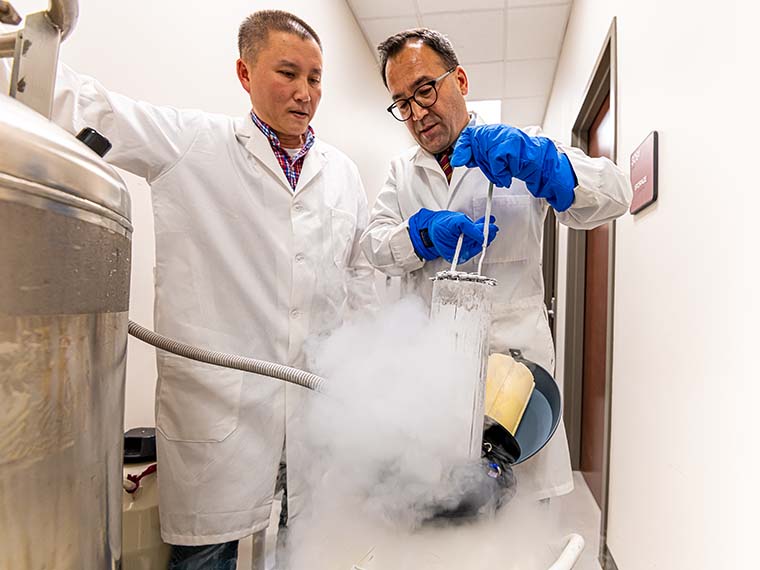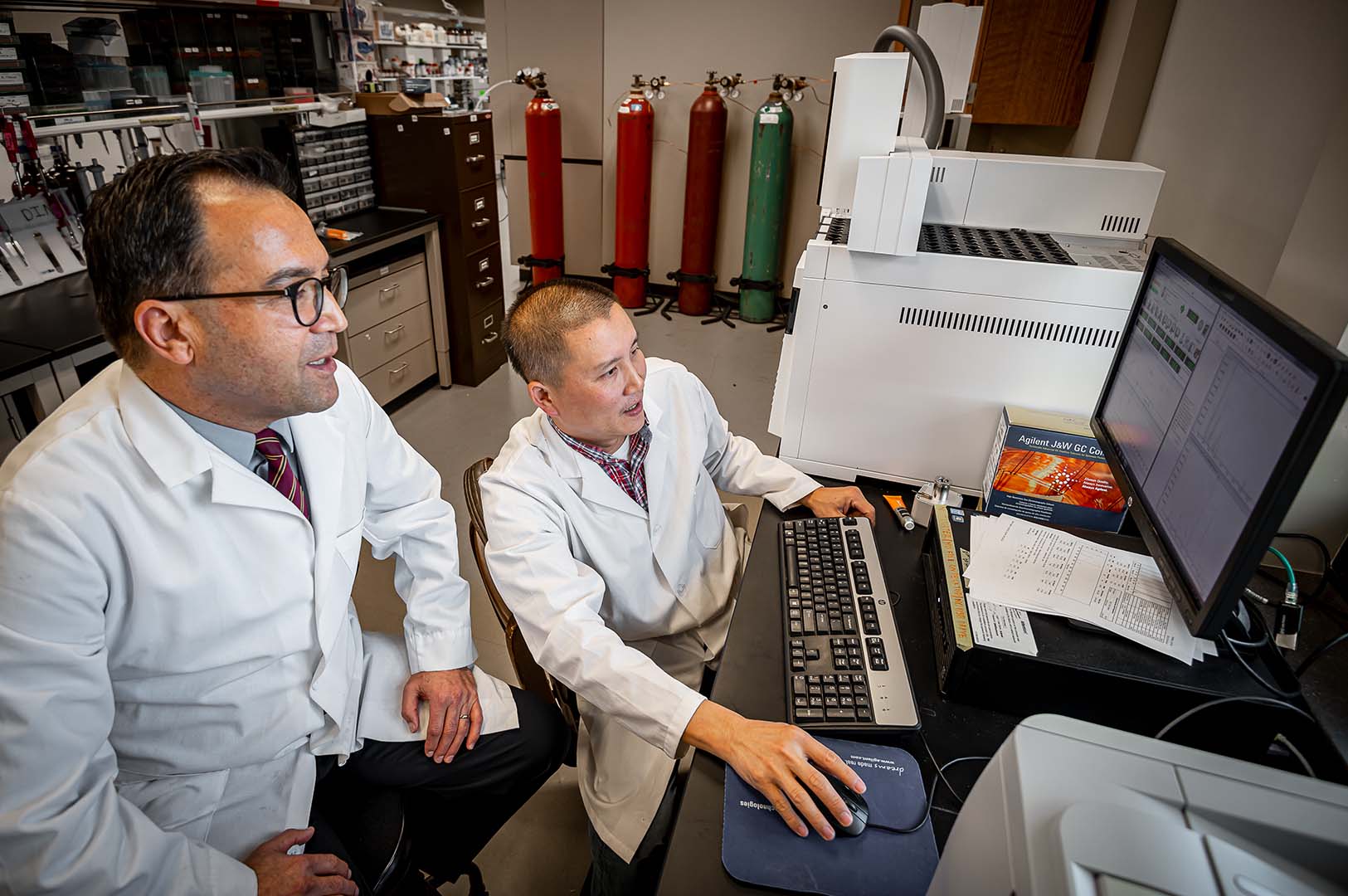The information presented on this page may be dated. It may refer to situations which have changed or people who are no longer affiliated with the university. It is archived as part of Mississippi State University's history.
We often underestimate the importance of the little things. But at MSU's Department of Animal and Dairy Sciences, Dr. Erdo?an Memili is aware of just how small things can make a big difference when it comes to the business of breeding cattle.
Although bull fertility is an essential factor in livestock production, the conventional methods of predicting fertility have been historically unreliable and tedious despite advances in management software and statistical models.
Dr. Memili, a MAFES scientist, and his research team recently discovered that sperm Protamine 1 (PRM1), a biomarker associated with bull fertility, can be successfully used to evaluate semen quality and predict bull fertility. This small-scale discovery promises to have global impacts on the production of livestock and worldwide food security.
"We have identified the need for a powerful set of biomolecular markers to evaluate semen quality and predict sire fertility," Memili said. "This discovery gives us a very specific plan for the successful efficient reproduction of livestock cattle for sustainable animal agriculture."
In this MAFES-funded study, Memili had the opportunity to forge a partnership between industry and academia. Mr. Einko Topper and Dr. Abdullah Kaya from Alta Genetics Inc. provided sperm samples and fertility phenotypic data from their breeding bulls. On the academic side, Dr. John Parrish from the University of Wisconsin-Madison and Dr. Peter Sutovsky from the University of Missouri-Columbia collaborated on the scientific research, and Memili's former Ph.D. student, Dr. Sule Dogan, currently the onsite laboratory director at IVF Michigan, was the lead researcher.
The livestock production industry has bred cattle by artificial insemination for over 50 years. Cows are inseminated with cryopreserved sperm from the best breeding bulls, which have high fertility and other economically important genetic traits. In theory, the nature of this practice makes economic sense in that farmers do not have to spend their resources rearing and caring for a bull onsite when they can simply have quality bull sperm cryopreserved and shipped to the farm. The results of the artificial insemination process, however, are not always as predicted or desired.
"My students and I saw this problem as an opportunity," Memili said. "We set out to look for biomarkers in sperm that would predict levels of fertility. The state-of-the-art facilities at Mississippi State helped us tackle this gap in knowledge and technology."
Another complication in the practice of mass artificial insemination is the amount of time it takes to identify the bulls with the most fertile sperm.
"It takes years to evaluate a bull for semen quality, and conventional methods are not sensitive enough. We want precision identification of the bull's fertility. There were gaps in knowledge and technology that we needed to address," Memili said.
The team examined sperm from phenotypically distinct Holstein bulls-those with high fertility and those with low fertility. They used tools common in modern biology such as immunoblotting, immunocytochemistry, and flow cytometry to ascertain the expression dynamics of PRM1 in the sperm. In addition, they applied Halomax and Toluidine blue staining methods to determine the quality of sperm DNA. Using these different methods, the team found that the sperm from the high-fertility bulls had consistently greater levels of PRM1.
PRM1 is the major nuclear protein not only in cattle but in all mammals, to varying degrees. The main function of this protein, Memili explained, is to make the DNA compact, resulting in a sperm head that facilitates motility, or movement. Higher levels of PRM1 also protect the sperm DNA from chemical damage and embryo mortality. Thus, the higher the PRM1 level, the stronger the sperm will be in the insemination process.
Memili underscored the importance of his partnership with industry on this project. He also credits the students and scholars who have helped him over the years to reach this milestone. The findings from this collaborative effort are highly cited and being used in a wide array of applications.
"Scientists are using this protamine as a marker in other species, including humans. Male fertility is declining around the world, and in the field of reproductive technology, this protamine is being used as a marker to predict fertility in humans. It can also be used in other species, including endangered species," Memili added.
Since the original study, Memili has begun to expand the research. In addition to PRM1, he is looking to identify additional sperm fertility biomarkers using transcriptomics, metabolomics, and lipidomics. He also received a competitive grant from USDA NIFA and is collaborating on metabolomics research with Dr. Thu Dinh, MAFES scientist and associate professor in the Department of Animal and Dairy Sciences.
"We need a more powerful and comprehensive set of markers. Combined with protein markers such as PRM1, these metabolomic markers can be used in bull soundness exams to predict male fertility with much higher confidence," Memili said.
Memili is also exploring attributes of PRM1 in addition to levels to determine whether other attributes of the protamine are associated with higher bull sperm quality and fertility. Their goal is to identify as many markers as possible that indicate fertility and economically valuable traits, including growth and development, number of females produced, milk production of female offspring, resistance to disease, and feed efficiency.
"There are some bulls with over one million progenies, so one bull can have a huge genetic influence in the population," Memili said. "That means a fertility difference of .05 or even .01 translates into thousands, even millions, of dollars in savings."
Cow conception rates vary widely, anywhere from 10 to 70 percent, according to Memili, and low fertility rates result in huge economic losses for producers.
Today, scientists have the genetic blueprint of most bulls and many cows, but genetic markers alone are not enough, Memili noted. Some of these economically valuable traits, including fertility, are not determined by genetics alone. About 85 percent of fertility is determined by environmental factors such as nutrition, management, and weather.
"Having these functional genomic markers is quite powerful because the environment influences the levels of Protamine-1," Memili stated. "Our markers can be combined with genomic markers to enhance the accuracy of predicting the phenotype. That's the value of our research."
Memili has a great appreciation for how his research fits into the bigger picture of livestock and food production. Growing up on a goat farm, he learned the importance of food animal production from an early age.
"It still resonates in my mind how important it is to raise livestock, in this case cattle, to feed the world," he said.
This research is funded by the Mississippi Agricultural and Forestry Experiment Station and the USDA National Institute of Food and Agriculture. Collaborators include Dr. Molly Nicodemus, associate professor, and Dr. Dean Jousan, associate extension professor, both in the MSU Department of Animal and Dairy Sciences; Alta Genetics Inc.; University of Wisconsin-Madison; and the University of Missouri-Columbia.
There are some bulls with over one million progenies, so one bull can have a huge genetic influence in the population. That means a fertility difference of .05 or even .01 translates into thousands, even millions, of dollars in savings.
Dr. Erdogan Memili
Behind the Science

Erdogan Memili
Professor
Education: M.S., Bacteriology; Ph.D., Endocrinology and Reproductive Physiology, University of Wisconsin-Madison; DVM, Doctor of Veterinary Medicine, Istanbul University
Years At MSU: 7
Focus: Using systems biology approaches to determine biomolecular markers and mechanisms to enhance reproductive efficiency and product quality of livestock
Passion At Work: My passion and purpose are to make positive impacts on animal science and biotechnology, education, and the society. I am also passionate about developing active linkages between the research and teaching to empower students with knowledge and skills.

Thu Dinh
Associate Professor
Education: B.E., Food Technology, HCMC University of Technology; M.S., Food Technology; Ph.D., Animal Science, Texas Tech University Years at MSU: 7
Years At MSU: 7
Focus: Meat quality and safety; analytical methodology for animal and meat science research
Passion At Work: I consider myself a scientist butcher who is committed to developing solutions for high-quality and safe meat products.


